Abstract
An investigation was made of the effect of changing mean transit time (MTT) by administration of drugs which affect colonic motility on faecal microbial mass in man. Senokot was used to accelerate and codeine and/or loperamide to prolong transit in subjects maintained on a constant high fibre diet. Doses of Senokot or codeine/loperamide were adjusted to halve or double transit time measured during a three week control period on diet alone. Stools were collected throughout and analysed for bacterial mass by a gravimetric procedure. Transit was measured by a continuous marker method. Senokot decreased mean transit time from 63.9 to 25.0 hours (n = 6), with increased stool weight from 148 to 285 g/day. Bacterial mass increased in all subjects from a mean of 16.5 to 20.3 g/day (dry weight) (p less than 0.025). Codeine/loperamide increased mean transit time from 47.1 to 87.6 hours (n = 5), with decreased stool weight from 182 to 119 g/day. Bacterial mass decreased in all but one subject from a mean of 18.9 to 16.1 g/day (NS). There was a significant correlation between transit time and bacterial mass in all three periods (r = 0.77, p less than 0.001). Changes in transit time are shown to alter microbial growth in the human colon and result in altered stool output, on a constant diet. Factors which affect transit may be as important as diet in determining large bowel function and hence susceptibility to disease.
Full text
PDF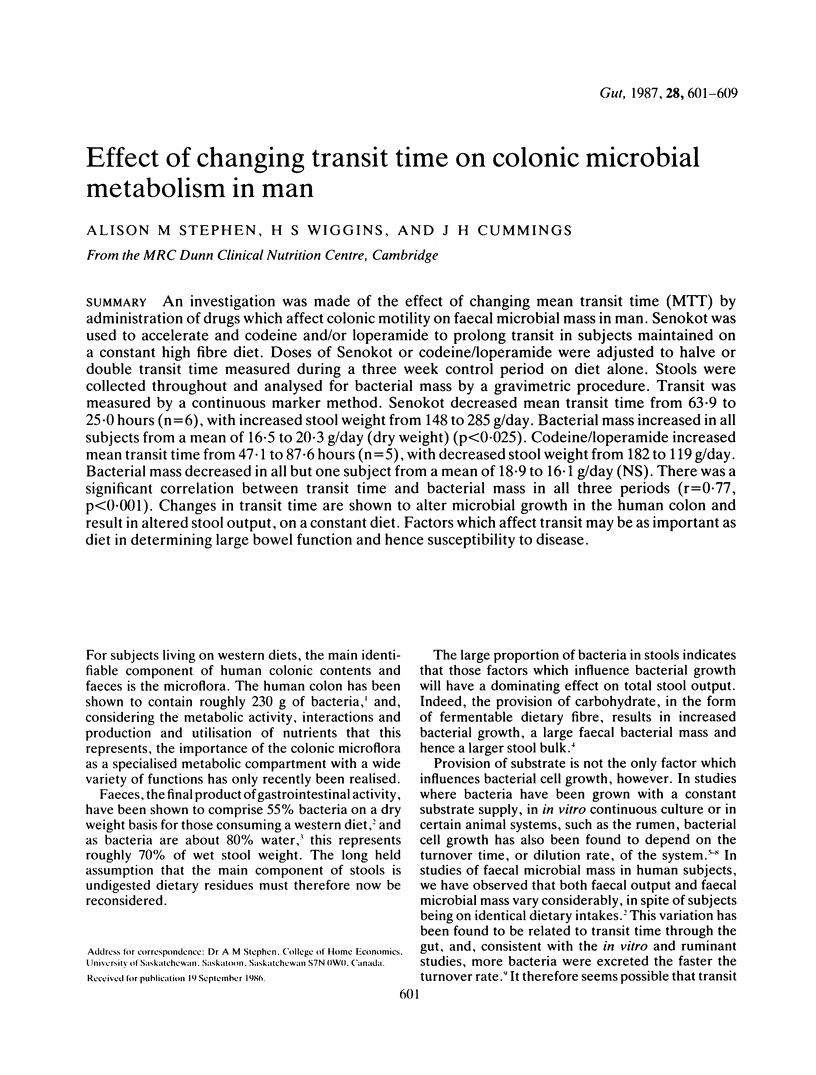
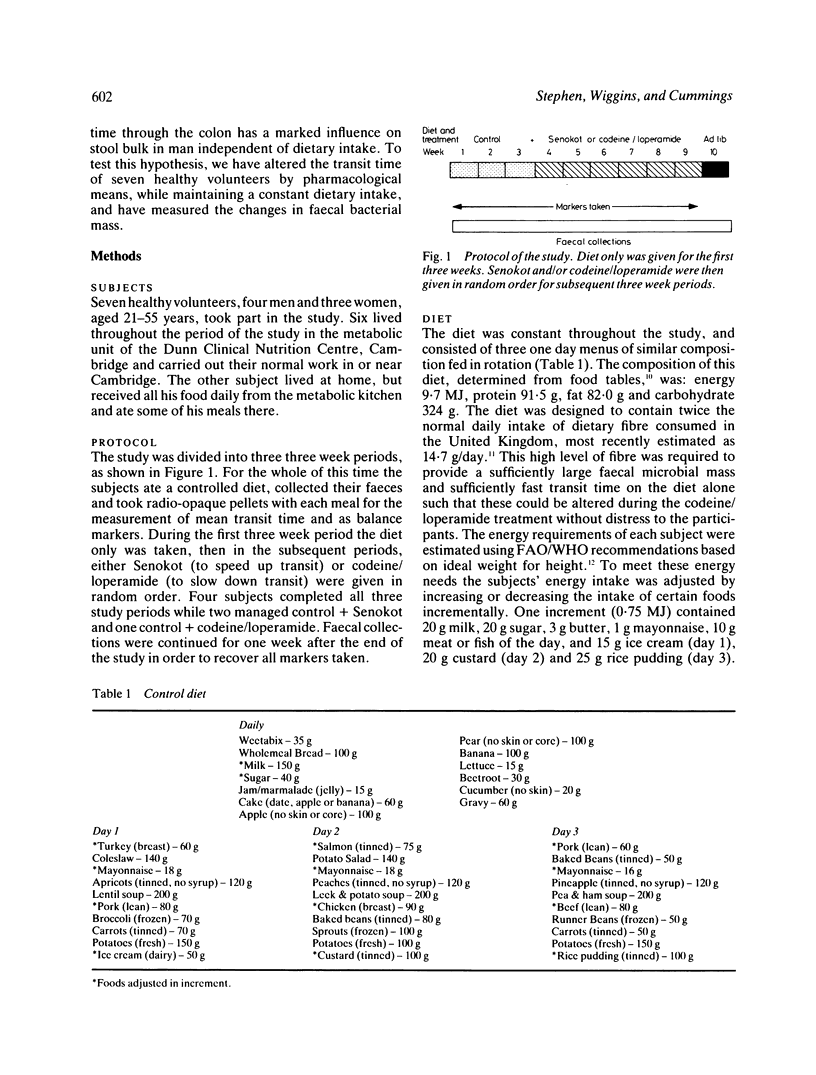
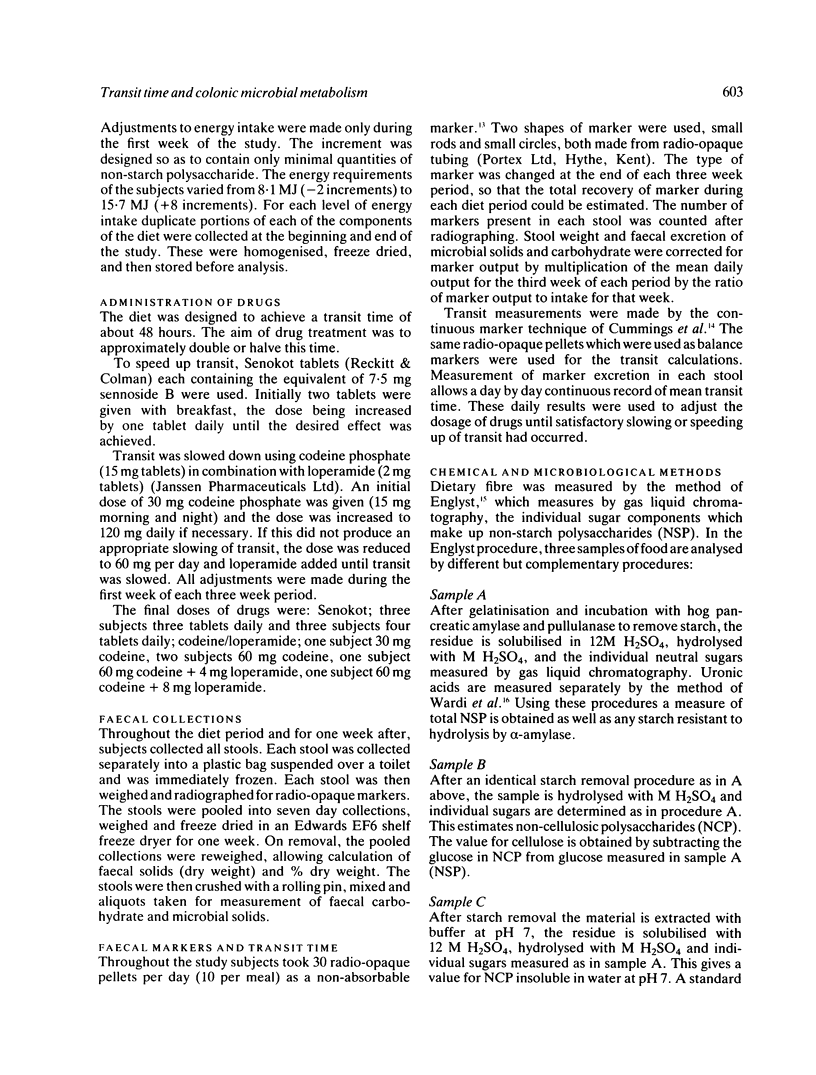

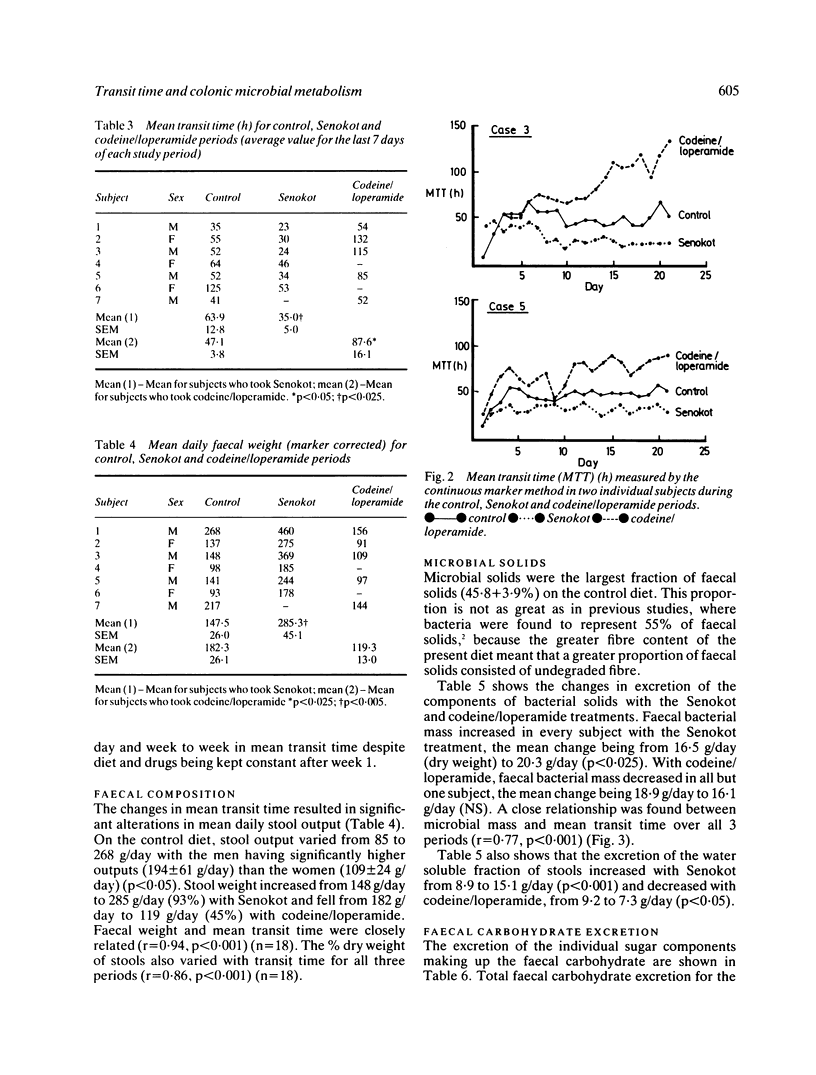
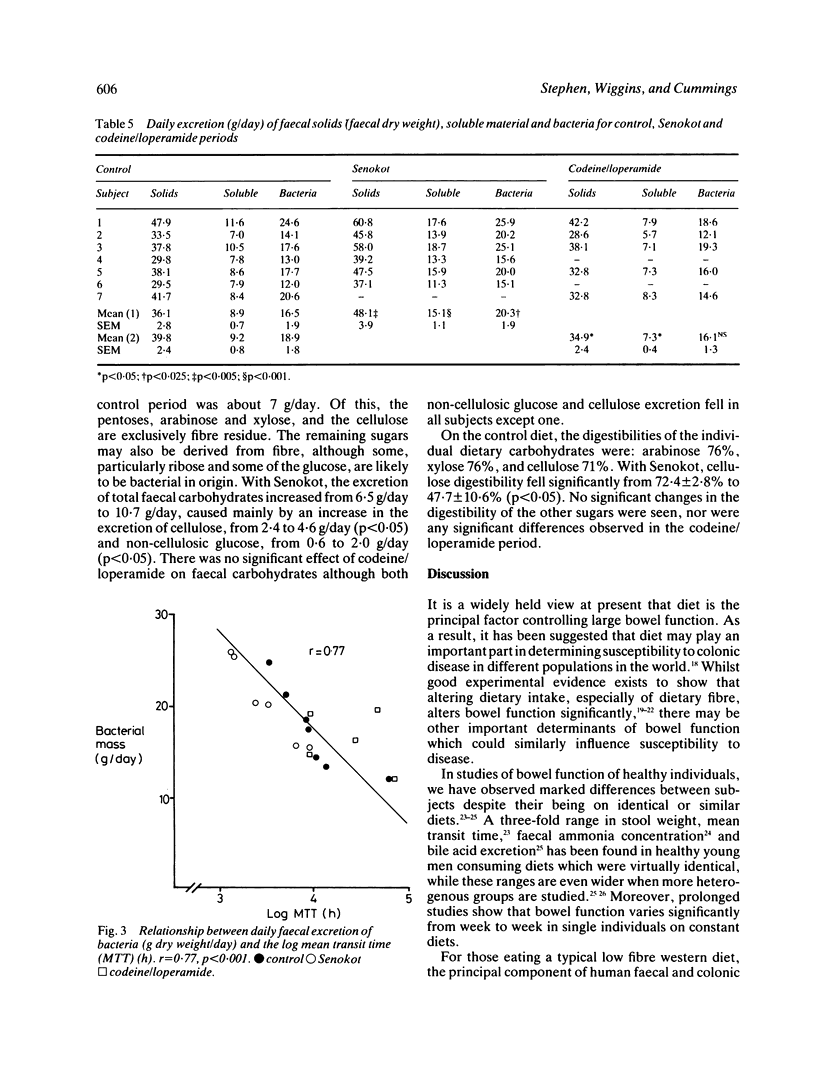

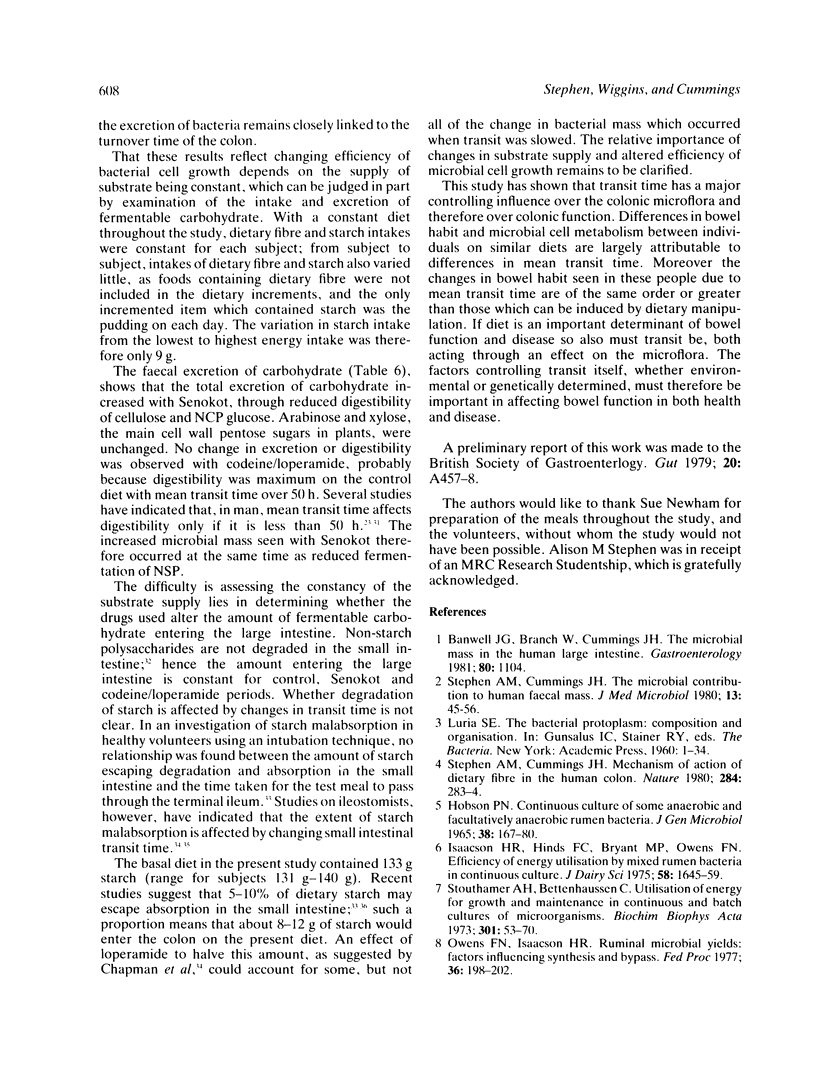
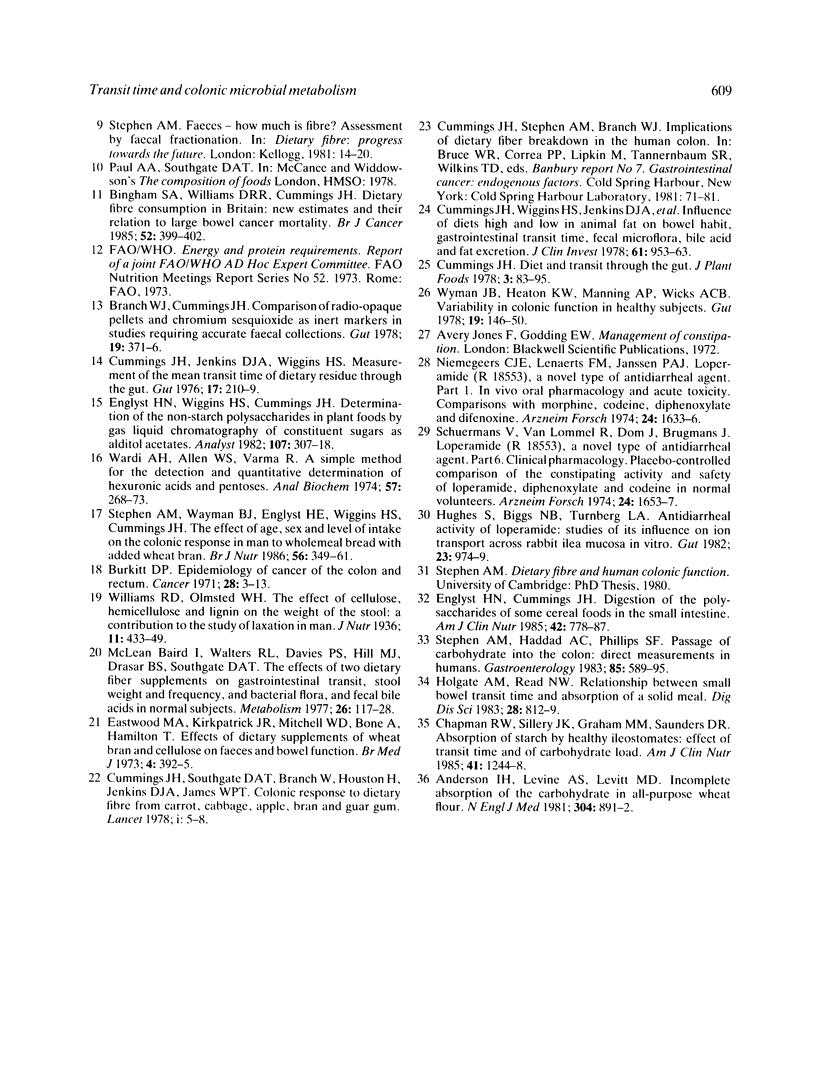
Selected References
These references are in PubMed. This may not be the complete list of references from this article.
- Baird I. M., Walters R. L., Davies P. S., Hill M. J., Drasar B. S., Southgate D. A. The effects of two dietary fiber supplements on gastrointestinal transit, stool weight and frequency, and bacterial flora, and fecal bile acids in normal subjects. Metabolism. 1977 Feb;26(2):117–128. doi: 10.1016/0026-0495(77)90047-6. [DOI] [PubMed] [Google Scholar]
- Bingham S. A., Williams D. R., Cummings J. H. Dietary fibre consumption in Britain: new estimates and their relation to large bowel cancer mortality. Br J Cancer. 1985 Sep;52(3):399–402. doi: 10.1038/bjc.1985.207. [DOI] [PMC free article] [PubMed] [Google Scholar]
- Branch W. J., Cummings J. H. Comparison of radio-opaque pellets and chromium sesquioxide as inert markers in studies requiring accurate faecal collections. Gut. 1978 May;19(5):371–376. doi: 10.1136/gut.19.5.371. [DOI] [PMC free article] [PubMed] [Google Scholar]
- Burkitt D. P. Epidemiology of cancer of the colon and rectum. Cancer. 1971 Jul;28(1):3–13. doi: 10.1002/1097-0142(197107)28:1<3::aid-cncr2820280104>3.0.co;2-n. [DOI] [PubMed] [Google Scholar]
- Chapman R. W., Sillery J. K., Graham M. M., Saunders D. R. Absorption of starch by healthy ileostomates: effect of transit time and of carbohydrate load. Am J Clin Nutr. 1985 Jun;41(6):1244–1248. doi: 10.1093/ajcn/41.6.1244. [DOI] [PubMed] [Google Scholar]
- Cummings J. H., Branch W., Jenkins D. J., Southgate D. A., Houston H., James W. P. Colonic response to dietary fibre from carrot, cabbage, apple, bran. Lancet. 1978 Jan 7;1(8054):5–9. doi: 10.1016/s0140-6736(78)90357-4. [DOI] [PubMed] [Google Scholar]
- Cummings J. H., Jenkins D. J., Wiggins H. S. Measurement of the mean transit time of dietary residue through the human gut. Gut. 1976 Mar;17(3):210–218. doi: 10.1136/gut.17.3.210. [DOI] [PMC free article] [PubMed] [Google Scholar]
- Cummings J. H., Wiggins H. S., Jenkins D. J., Houston H., Jivraj T., Drasar B. S., Hill M. J. Influence of diets high and low in animal fat on bowel habit, gastrointestinal transit time, fecal microflora, bile acid, and fat excretion. J Clin Invest. 1978 Apr;61(4):953–963. doi: 10.1172/JCI109020. [DOI] [PMC free article] [PubMed] [Google Scholar]
- Eastwood M. A., Kirkpatrick J. R., Mitchell W. D., Bone A., Hamilton T. Effects of dietary supplements of wheat bran and cellulose on faeces and bowel function. Br Med J. 1973 Nov 17;4(5889):392–394. doi: 10.1136/bmj.4.5889.392. [DOI] [PMC free article] [PubMed] [Google Scholar]
- Englyst H. N., Cummings J. H. Digestion of the polysaccharides of some cereal foods in the human small intestine. Am J Clin Nutr. 1985 Nov;42(5):778–787. doi: 10.1093/ajcn/42.5.778. [DOI] [PubMed] [Google Scholar]
- Englyst H., Wiggins H. S., Cummings J. H. Determination of the non-starch polysaccharides in plant foods by gas-liquid chromatography of constituent sugars as alditol acetates. Analyst. 1982 Mar;107(1272):307–318. doi: 10.1039/an9820700307. [DOI] [PubMed] [Google Scholar]
- HOBSON P. N. CONTINUOUS CULTURE OF SOME ANEROBIC AND FACULTATIVELY ANAEROBIC RUMEN BACTERIA. J Gen Microbiol. 1965 Feb;38:167–180. doi: 10.1099/00221287-38-2-167. [DOI] [PubMed] [Google Scholar]
- Holgate A. M., Read N. W. Relationship between small bowel transit time and absorption of a solid meal. Influence of metoclopramide, magnesium sulfate, and lactulose. Dig Dis Sci. 1983 Sep;28(9):812–819. doi: 10.1007/BF01296904. [DOI] [PubMed] [Google Scholar]
- Hughes S., Higgs N. B., Turnberg L. A. Antidiarrhoeal activity of loperamide: studies of its influence on ion transport across rabbit ileal mucosa in vitro. Gut. 1982 Nov;23(11):974–979. doi: 10.1136/gut.23.11.974. [DOI] [PMC free article] [PubMed] [Google Scholar]
- Isaacson H. R., Hinds F. C., Bryant M. P., Owens F. N. Efficiency of energy utilization by mixed rumen bacteria in continuous culture. J Dairy Sci. 1975 Nov;58(11):1645–1659. doi: 10.3168/jds.S0022-0302(75)84763-1. [DOI] [PubMed] [Google Scholar]
- Niemegeers C. J., Lenaerts F. M., Janssen P. A. Loperamide (R 18 553), a novel type of antidiarrheal agent. Part 1: in vivo oral pharmacology and acute toxicity. Comparison with morphine, codeine, diphenoxylate and difenoxine. Arzneimittelforschung. 1974 Oct;24(10):1633–1636. [PubMed] [Google Scholar]
- Owens F. N., Isaacson H. R. Ruminal microbial yields: factors influencing synthesis and bypass. Fed Proc. 1977 Feb;36(2):198–202. [PubMed] [Google Scholar]
- Schuermans V., Van Lommel R., Dom J., Brugmans J. Loperamide (R 18 553), a novel type of antidiarrheal agent. Part 6: Clinical pharmacology. Placebo-controlled comparison of the constipating activity and safety of loperamide, diphenoxylate and codeine in normal volunteers. Arzneimittelforschung. 1974 Oct;24(10):1653–1657. [PubMed] [Google Scholar]
- Stephen A. M., Cummings J. H. Mechanism of action of dietary fibre in the human colon. Nature. 1980 Mar 20;284(5753):283–284. doi: 10.1038/284283a0. [DOI] [PubMed] [Google Scholar]
- Stephen A. M., Cummings J. H. The microbial contribution to human faecal mass. J Med Microbiol. 1980 Feb;13(1):45–56. doi: 10.1099/00222615-13-1-45. [DOI] [PubMed] [Google Scholar]
- Stephen A. M., Haddad A. C., Phillips S. F. Passage of carbohydrate into the colon. Direct measurements in humans. Gastroenterology. 1983 Sep;85(3):589–595. [PubMed] [Google Scholar]
- Stephen A. M., Wiggins H. S., Englyst H. N., Cole T. J., Wayman B. J., Cummings J. H. The effect of age, sex and level of intake of dietary fibre from wheat on large-bowel function in thirty healthy subjects. Br J Nutr. 1986 Sep;56(2):349–361. doi: 10.1079/bjn19860116. [DOI] [PubMed] [Google Scholar]
- Stouthamer A. H., Bettenhaussen C. Utilization of energy for growth and maintenance in continuous and batch cultures of microorganisms. A reevaluation of the method for the determination of ATP production by measuring molar growth yields. Biochim Biophys Acta. 1973 Feb 12;301(1):53–70. doi: 10.1016/0304-4173(73)90012-8. [DOI] [PubMed] [Google Scholar]
- Wardi A. H., Allen W. S., Varma R. A simple method for the detection and quantitative determination of hexuronic acids and pentoses. Anal Biochem. 1974 Jan;57(1):268–273. doi: 10.1016/0003-2697(74)90072-4. [DOI] [PubMed] [Google Scholar]
- Wyman J. B., Heaton K. W., Manning A. P., Wicks A. C. Variability of colonic function in healthy subjects. Gut. 1978 Feb;19(2):146–150. doi: 10.1136/gut.19.2.146. [DOI] [PMC free article] [PubMed] [Google Scholar]


